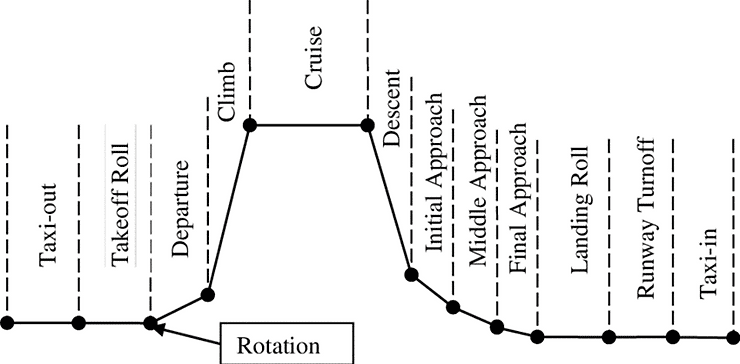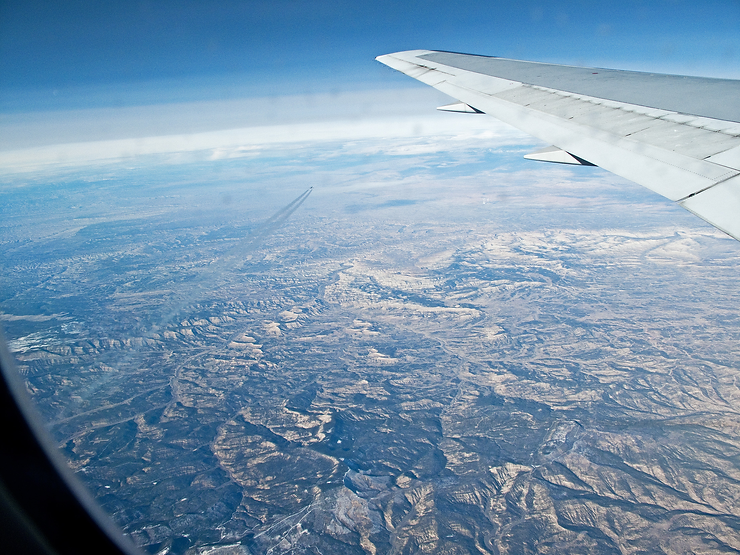Flight Mechanics of a Typical Aircraft Flight
Updated: Nov 14, 2022
This article will give a brief overview of a typical flight of an aircraft, discussing the different stages within a typical flight and link this to some of the topics in flight mechanics.

Figure 1 – Phases within a typical flight
Figure 1 has split a typical flight into various phases. The phases that w shall discuss are the Take-off, Climb, Cruise, Descent, and Landing phases.
Take Off
Take-off is the phase of flight in which an aircraft goes through a transition from moving along the ground to flying in the air. Usually, the engines are operated at full power during take-off. Following the taxi motion, the aircraft stops at the starting line of the runway. Before take-off, the engines, particularly piston engines, are routinely run up at high power to check for engine related problems. When the pilot releases the brakes, the aircraft starts accelerating rapidly until the necessary speed for take-off is achieved. The increase in velocity dramatically increases the lift force generated from the wings.

The take-off speed required varies with air density (and hence the altitude of the runway relative to sea-level), aircraft weight, and aircraft configuration. During take-off an aircraft will typically deploy and extend the flaps by 10 to 15 degrees, increasing the wing area and camber and hence considerably increasing the lift generated. Air density is affected by factors such as elevation and air temperature, and more lift is required when density is lower at higher altitude runways for instance.
Climb
Following take-off, the aircraft must climb to a certain altitude (typically 30,000 ft or 10 km for commercial jet airliners) before it can cruise at this altitude in a safe and economical way. A climb is carried out by increasing the lift from the wings supporting the aircraft until their lifting force exceeds the weight of the aircraft. Once this occurs, the aircraft will climb to a higher altitude until the lifting force and weight are again in balance. The increase in lift may be accomplished by increasing the angle of attack of the wings, by increasing the thrust of the engines to increase speed or by increasing the surface area or shape of the wing. In most cases, engine thrust, and angle of attack are simultaneously increased to produce a climb.
Because lift diminishes with decreasing air density, a climb, once initiated, will end by itself when the diminishing lift with increasing altitude drops to a point that equals the weight of the aircraft. At that point, the aircraft will return to level flight at a constant altitude. At this point, or just after take-off, aircraft will often begin a turn using a combination of ailerons to bank or roll and the rudder to combat adverse yaw. Aircraft may begin turning as early as possible to adhere to noise restrictions above urban areas or to avoid regions with high amounts of air traffic.
Cruise
Cruise is the level portion of aircraft travel where flight is most fuel efficient. It occurs between ascent and descent phases and is usually most of the journey. Technically, cruising consists of heading changes only at a constant airspeed and altitude. It ends as the aircraft approaches the destination where the descent phase of flight commences in preparation for landing.

Commercial or passenger aircraft are usually designed for optimum performance at their cruise speed. There is also an optimum cruise altitude for a particular aircraft type and conditions including payload weight, centre of gravity, air temperature, humidity, and airspeed. This altitude is usually where the drag is minimum, and the lift is maximum (often referred to as the maximum lift to drag ratio). The aircraft will be in straight and level flight at this stage.
Descent
A descent during air travel is any portion where an aircraft decreases altitude. Descents are an essential component of an approach to landing. Other partial descents might be to avoid traffic, poor flight conditions, clouds, to see something lower, to enter warmer air, or to take advantage of wind direction.
Normal descents take place at a constant airspeed and constant angle of descent. The pilot controls the angle of descent by varying engine power and pitch angle to keep the airspeed constant. At the beginning of and during the descent phase, the engine noise diminishes further as the engines are operated at low power settings. This reduces the thrust of the aircraft and decreases its speed, and therefore lift. However, towards the end of the descent phase, the passenger can feel further accelerations and an increase in the noise.
Landing
Landing is the last part of a flight, where the aircraft returns to the ground. Aircraft usually land at an airport on a firm runway, generally constructed of asphalt concrete, concrete, gravel or grass. To land, the airspeed and the rate of descent are reduced to where the object descends at a slow enough rate to allow for a gentle touch down. Landing is accomplished by slowing down and descending to the runway. This speed reduction is achieved by reducing thrust and inducing a greater amount of drag using flaps, landing gear or speed brakes.

As the plane approaches the ground, the pilot will execute a flare (to induce a gentle landing). Although pilots are trained to perform the landing operation, many aircraft rely on so-called “Instrument Landing Systems (ILS)” in most airports to help land the aircraft safely and accurately. ILS provides precision guidance to an aircraft approaching and landing on a runway, using a combination of radio signals and, in many cases, high-intensity lighting arrays to enable a safe landing during instrument meteorological conditions (IMC), such as low ceilings or reduced visibility due to fog, rain, or blowing snow.
Accredited Aerospace Engineering Courses
This is a small excerpt from iLearn Engineering®‘s suite of accredited Aerospace Engineering courses all of which are available for enrolment 365 days a year.
Why not check out the online engineering short courses specifically in aerospace engineering:
Diploma in Aerospace Structures
Diploma in Principles of Flight
Diploma in Aerodynamics, Propulsion and Space
Alternatively, you can view all our online engineering courses here.
Recent Posts
What are the principles of inductance and capacitance?
What are the principles of inductance and capacitance? In our previous article on inductance, we jumped into the behaviour of inductance and what it is. Now we’re going to look at the principles of inductance, as well as the principles of capacitance. Inductance and Capacitance. We’ve already touched on the surface of inductance in our […]
How can we analyse a single-degree-of-freedom lumped parameter systems with damping?
How can we analyse a single-degree-of-freedom lumped parameter system with damping? In our previous article on undamped vibration, we looked at solving vibration problems with a single degree of freedom. In this article, we’re going to look at systems with damping and how to analyse them. We’ll focus on the mathematical analysis of a single-degree-of-freedom […]
How can we analyse undamped vibration problems.
How can we analyse undamped vibration problems. In our previous article on harmonic motion, we looked at how we can analyse problems involving simple harmonic motion, now we’re going to look at solving vibration problems with a single degree of freedom. Vibration Analysis In vibration analysis, there are two approaches we are interested in. One […]

